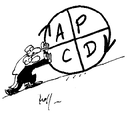The PDCA (Plan, Do, Check, Act) cycle, also referred to as PDSA (Plan, Do, Study, Act), was made popular by Dr. W. Edwards Deming. He recommended that business processes be placed in a continuous feedback loop so that managers can identify and change the parts of the process that need improvements.
Many consultants use this model the wrong way around. Instead of using this model to introduce a plan and see if it works in the environment they already make a decision (act) and then use to model to force the employees to use it. As  this video shows Deming intended the model to study if a plan worked and then decided to adopt, abandon or change it.
this video shows Deming intended the model to study if a plan worked and then decided to adopt, abandon or change it.
If we use the cycle as Deming intended we can use it to ease the resistance of employees to changes in a business.
It al starts with a plan, this plan should include to pros and cons of the new situation as well as the pros and cons for the current situation, keep in mind that these pro’s and con’s can be different for different employees. Watch this video for a visual presentation of this concept.
After creating the plan you should introduce the plan (Do) and implement it on a small scale so everybody can get used to the idea. This step assures that everybody understands what is coming and why.
Study the employees. Identify the promoters and opponents of the plan. What is the overall concences about the plan? Why are people resisting the plan. The five main reasons why people resist changes in organization are:
1.Employees were not aware of the underlying business need for change.
2.Lay-offs were announced or feared as part of the change.
3.Employees were unsure if they had the needed skills for success in the future state.
4.Individuals were comfortable with the current state; they wanted to maintain the personal rewards and sense of accomplishment and fulfillment provided by the status quo.
5.Employees felt they were being required to do more with less, or do more for the same pay.
Now you should act on the results of the study. If the cumulative resistance is smaller than the dissatisfaction times the desirability times the practically, you should adopt the change. If not you should either change the plan with the help of some of the opponents’ leaders or abandon the plan.
After finishing the first circle the plan needs adaption or further implementation. Therefore you need to start again with the plan, do, study, act cycles till you implemented the whole plan. Don’t make the same mistake over and over again.
